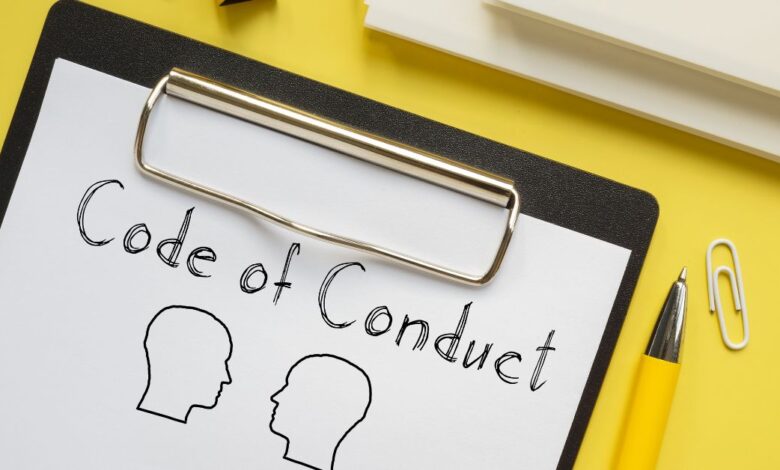Strengthening Corporate Governance with a Robust Code of Conduct

Brought to you by Compyl:
A code of conduct is more than just a set of guidelines — it’s the backbone of corporate integrity and accountability. It sets the foundation for the decision-making processes and defines the ethical framework within which a company operates.
This is particularly crucial in today’s environment, where stakeholders, from shareholders to consumers, demand transparency and ethical handling of business operations. Implementing a robust code of conduct enhances corporate governance and ensures that a company maintains its good standing in the market, thereby securing its long-term success.
Defining Corporate Governance and Its Importance
Corporate governance refers to the systems, principles, and processes by which a company is directed and controlled. It encompasses the mechanisms through which companies and those in control are held to account.
Good governance should balance the interests of a company’s many stakeholders, such as shareholders, management, customers, suppliers, financiers, government, and the community. Without a solid framework of governance, a company risks mismanagement, corruption, and potential scandals—all of which can lead to financial loss and damaged reputations.
Key Elements of an Effective Code of Conduct
A well-crafted code of conduct serves as a critical tool in corporate governance by outlining clear expectations for behavior and providing a benchmark for ethical decision-making. These elements collectively uphold the ethical framework of the organization, ensure alignment with broader business goals, and mitigate risks by setting clear and enforceable standards.
By establishing these guidelines, organizations empower their employees to make decisions that align with corporate values, fostering a culture of integrity that can permeate all levels of operations. Essential elements include:
- Values and Ethical Standards: This section defines the core values of the organization and the standards of behavior expected from all employees.
- Compliance with Laws: A commitment to operate within the scope of applicable laws and regulations.
- Conflicts of Interest: Guidelines on how to identify and handle situations where personal interests could conflict with the interests of the company.
- Confidentiality and Privacy: Directives on how to manage sensitive information.
- Respect in the Workplace: Ensuring a workplace free of harassment and discrimination.
Each element must be communicated effectively and be accessible to all employees to foster a culture of integrity and compliance.
How a Code of Conduct Supports Ethical Decision Making
A code of conduct provides a reference point that employees can use to guide their choices in complex situations. It helps prevent unethical behavior by clearly stating what is unacceptable, thereby reducing ambiguity and the potential for misinterpretation. A comprehensive code encourages a dialogue about ethics and compliance, which helps to reinforce a company’s ethical climate.
Implementing the Code: Steps for Success
Implementing a code of conduct effectively is as crucial as the content of the code itself. Effective implementation requires a comprehensive strategy that not only communicates the details of the code to all employees but also integrates it into the corporate culture through ongoing support and reinforcement.
These steps are designed to ensure that the code of conduct is not merely a document but a dynamic aspect of everyday business practice that enhances compliance and ethical behavior across the company.
Steps for successful implementation include:
- Leadership Endorsement: The code should have strong backing from the top management to demonstrate its importance within the company.
- Training and Education: Regular training sessions should be conducted to ensure that all employees understand the code’s contents and how to apply it in their roles.
- Clear Reporting Mechanisms: Employees should have clear, confidential channels to report suspected breaches of the code without fear of retaliation.
- Regular Updates: The code should be reviewed and updated regularly to respond to new challenges and ensure its relevance.
Monitoring and Updating the Code of Conduct
To ensure that a code of conduct remains effective and relevant, it must be treated as a living document that adapts in response to changes within the organization and its external environment. This ongoing process is critical in maintaining the applicability and effectiveness of the code, reflecting evolving legal requirements, ethical standards, and business practices.
Regular assessments are essential to gauge the code’s effectiveness, identify improvement areas, and implement necessary adjustments to address new challenges and opportunities. These evaluations help maintain the code’s alignment with the company’s goals and the expectations of its stakeholders.
The process of monitoring and updating the code involves several key activities:
- Soliciting Feedback from Employees: Engaging with employees to gather insights and perspectives on the practical aspects of the code’s implementation helps in identifying gaps and areas for enhancement.
- Monitoring Compliance: Regular checks to ensure adherence to the code are essential for reinforcing ethical behavior and addressing non-compliance proactively.
- Benchmarking Against Industry Best Practices: Comparing the code with those of peers and industry leaders can reveal insights into more effective practices and emerging trends that could enhance the company’s ethical standards.
Ethical Governance: Sustaining Integrity and Success
A robust code of conduct is indispensable in today’s business environment. It guides corporate governance and fortifies the company’s reputation and standing in the market.
By establishing clear ethical guidelines and implementing them with commitment and transparency, businesses can navigate the complex terrain of modern corporate operations while maintaining trust and integrity. A strong code of conduct thus serves not merely as a legal or formal requirement but as a cornerstone of sustainable success.
Reinforcing a code of conduct across an organization encourages a uniform understanding of what is expected from each individual, fostering a culture where ethical practices are valued and promoted. This alignment helps avoid ethical dilemmas and conflicts, reducing legal risks and enhancing the overall workplace environment.
In the end, a well-maintained code of conduct protects and adds value to the organization, contributing to its competitive edge in the industry. Companies prioritizing ethical governance are more likely to attract and retain top talent, secure investor confidence, and maintain a positive public image, all of which are essential for long-term prosperity.
Source link





